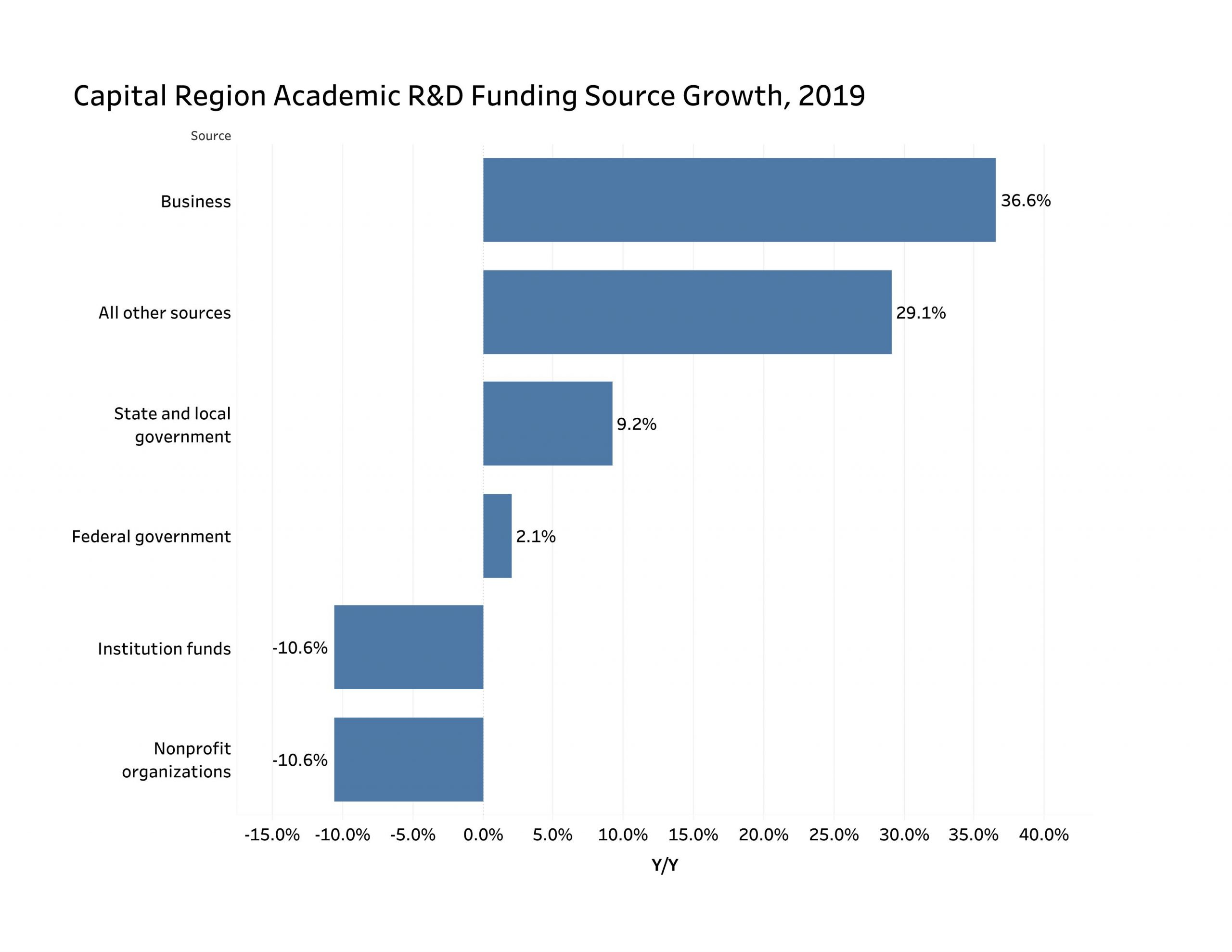Businesses Spent This Much More on R&D at Capital Region Colleges and Universities
R&D funded by businesses up 51% at RPI, 39% at SUNY Poly
Increased business funding helped fuel a 6.9 percent increase in research and development spending at Capital Region colleges and universities in 2019, according to a Center for Economic Growth (CEG) analysis of new data from that National Center for Science and Engineering Statistics (NCSES).
Spending & Sources
In 2019, nine academic institutions in the eight-county region spent $599.3 million on R&D that supported 3,831 jobs. Driving the spending growth were a 9.2 percent increase in state-funded R&D to $132.9 million and a 36.6 percent increase in business-funded R&D to $130.5 million. Business increased their spending by as much as 50.8 percent at Rensselaer Polytechnic Institute (RPI) to $14.2 million and 38.7 percent at SUNY Polytechnic Institute to $110.3 million.
“Rensselaer continues to grow its research enterprise through external collaborations with sponsors in the federal government, New York State, industry, and foundations, and through internal investments in faculty and platforms,” said RPI Acting Vice President for Research Robert Hull. “In the past year, Rensselaer researchers have made significant strides in biotechnology, artificial intelligence, advanced materials, cognitive science, high performance computing, and many other fields, and we look forward to even more transformative changes in future years.”

Institutions
SUNY Poly accounted for almost half of the R&D spending in 2019. Its R&D spending total increased by 9.8 percent to $282.4 million. In November 2019, Applied Materials opened at SUNY Polytechnic Institute a Material Engineering Technology Accelerator (META) Center. Also, in February 2019, IBM launched its AI Hardware Center at SUNY Poly.
The Albany College of Pharmacy and Health Sciences (ACPHS), which last month opened its Center for Biopharmaceutical Education and Training (CBET) at SUNY Poly’s Albany Nanotech Complex, had a 23.8 percent increase in R&D spending to $3.4 million. Skidmore College, which is doubling its R&D footprint with its Center for Integrated Sciences, had a 16.6 percent increase to $3 million. Union College, which last year opened its Integrated Science and Engineering Complex, had a 13 percent increase to $1.7 million.

“ACPHS’s increase in research funding is due to new faculty efforts in drug discovery and continuing strong efforts in drug development and anti-microbial drug resistance,” said ACPHS President Greg Dewey. “With major research efforts at RPI, SUNY Albany and SUNY Poly, the Capital Region offers a strong foundation in the basic and applied sciences. With the presence of a strong and growing pharmaceutical sector through large companies such as AMRI and Regeneron, and a small but growing number of small companies, the region has the opportunity to connect these strengths with a stronger effort in translational research, moving basic science discoveries into commercial products.”
“Skidmore College, our students, faculty and the community continue to benefit greatly from significant research grants provided by the National Institutes of Health, National Science Foundation, Department of Homeland Security, National Aeronautics and Space Administration, as well as other agencies and organizations,” said Skidmore spokesperson Sara Miga. “We have continued to experience growth in our research activities, which also coincides with construction of the Center for Integrated Sciences (CIS). CIS is the single largest academic initiative in Skidmore’s history and is a hub that fosters unique interdisciplinary connections between and among the sciences, arts, humanities and social sciences.”
The top R&D spenders in the region were SUNY Poly, followed by the University at Albany (up 4.9 percent to $181.5 million), Rensselaer Polytechnic Institute (up 2.9 percent to $103.7 million) and Albany Medical College (up 8.7 percent to $23 million). These four institutions accounted for 98.8 percent of the regions academic R&D spending and 94 percent of the 3,831 academic R&D personnel.

Fields
Among major R&D spending fields, engineering saw a 9.3 percent increase to $343.4 million. Life sciences R&D increased by 8.3 percent to $137.2 million, and computer and information sciences increased by 17.6 percent to $18.1 million. For insights into R&D projects in these fields at local colleges and universities, see editions of CEG’s Research Connection on nanotechnology R&D, advanced materials R&D, software R&D, cancer R&D, and COVID-19 R&D.

CEG Initiatives
CEG and its Business Growth Solutions (BGS) unit leverage the Capital Region’s R&D assets to do the following:
Promote the region around the world at industry conferences;
Improve businesses’ access to labs at facilities, such as those at SUNY Polytechnic Institute, Rensselaer Polytechnic Institute and others affiliated with Innovate 518, a University at Albany-led collaborative effort of Capital Region incubators, accelerators, and entrepreneurial service providers.
Accelerate commercialization by leveraging tech scouting, gathering technology-driven market intelligence, engaging Empire State Development’s Division of Science, Technology and Innovation (NYSTAR) for testing and development;
Develop prototypes with its Stratasys F270 3D printer at the Tech Valley Center of Gravity or provide hand-on access to it;
Assist in the preparation of grant applications for the National Institutes of Health (NIH), Small Business Innovation Research (SBIR) program and Small Business Technology Transfer Program; and
Identify potential investors and providing venture pitch coaching through the VentureB series.
Don’t miss these insights into the trends that are shaping the Capital Region’s economy. Sign up for CEG’s e-news and follow us on:













